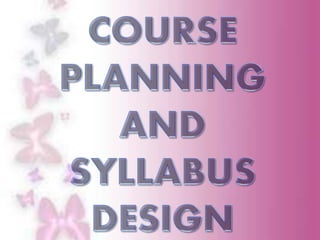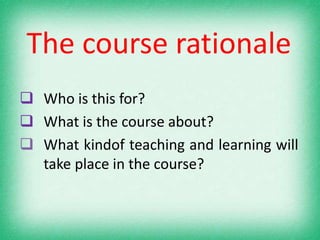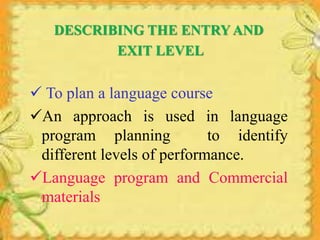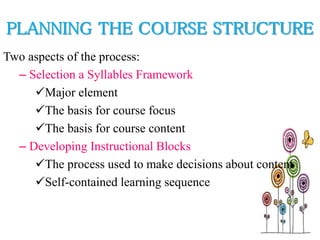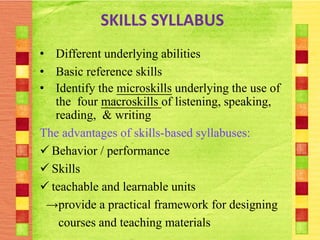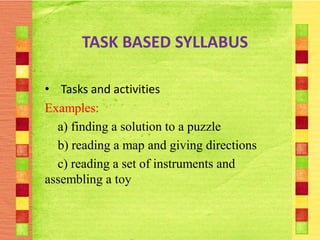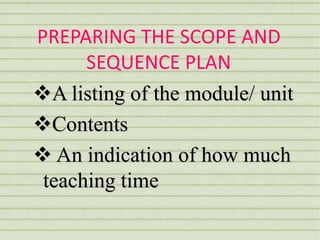Unit 1 Course planning and_syllabus_design
- 2. What is curriculum? What is syllabus?
- 3. The course rationale ’ü▒ Who is this for? ’ü▒ What is the course about? ’ü▒ What kindof teaching and learning will take place in the course?
- 4. DESCRIBING THE ENTRY AND EXIT LEVEL ’ā╝ To plan a language course ’ā╝An approach is used in language program planning to identify different levels of performance. ’ā╝Language program and Commercial materials
- 5. CHOOSING COURSE CONTENT ŌĆóTo develop to address a specific set of needs. ŌĆóTo cover a given set of objectives.
- 6. ’ü╝Simple and complex ’ü╝Chronology ’ü╝Need ’ü╝Prerequisite learning ’ü╝Whole to part or part to whole ’ü╝Spiaral sequencing DETERMINING THE SCOPE AND SEQUENCE
- 7. PLANNING THE COURSE STRUCTURE Two aspects of the process: ŌĆō Selection a Syllables Framework ’ā╝Major element ’ā╝The basis for course focus ’ā╝The basis for course content ŌĆō Developing Instructional Blocks ’ā╝The process used to make decisions about content ’ā╝Self-contained learning sequence
- 9. GRAMMATICAL SYLLABUS ŌĆó IT IS BASED ON GRAMMAR ŌĆó FOR PLANING A GENERAL COURSE ŌĆó FOR BEGINNING LEVEL ŌĆó REMAINS A CORE COMPONENTS
- 10. LEXICAL SYLLABUS ŌĆó TARGET VOCABULARY Elementary level: 1000 words Intermediate level: an additional 2000 words Upper intermediate level: an additional 2000 words Advanced level: an additional 2000+words
- 11. Communicative function Comunivative competence FUNCTIONAL SYLLABUS ADVANTAGE Comprehensive view Can readily be liked Framework DISADVANTAGE No clear criteria Simplistic view of CC Atomistic approach Lead to a phrase-book Considerable gaps in G-C
- 12. SITUATIONAL SYLLABUS ŌĆó Languge needed ŌĆó Identify the real situation ADVANTEGE Use in different situation Specific situation Phrase-book Gaps
- 13. TOPICAL OR CONTENT-BASED SYLLABUS ŌĆó Themes, or other units of content Advandage: ŌĆó Comprehension ŌĆó Meaningful ŌĆó Skill areas ŌĆó StudentsŌĆÖ needs ŌĆó Integration four skills ŌĆó Authentic materials
- 14. COMPETENCY-BASED SYLLABUS ŌĆó Competencies learners ŌĆó To specific situations and activities ŌĆó Skills, knowladge, and attitudes ŌĆó Particular tasks ans activities
- 15. SKILLS SYLLABUS ŌĆó Different underlying abilities ŌĆó Basic reference skills ŌĆó Identify the microskills underlying the use of the four macroskills of listening, speaking, reading, & writing The advantages of skills-based syllabuses: ’ā╝ Behavior / performance ’ā╝ Skills ’ā╝ teachable and learnable units ŌåÆprovide a practical framework for designing courses and teaching materials
- 16. TASK BASED SYLLABUS ŌĆó Tasks and activities Examples: a) finding a solution to a puzzle b) reading a map and giving directions c) reading a set of instruments and assembling a toy
- 17. AN INTEGRATES SYLLABUS ŌĆó Syllabus framework ŌĆó Teching ŌĆó Macrolevel and microlevel
- 19. ŌĆóMODULES This is a self-contained and independent learning sequence. ŌĆóUNITS ’ā╝ Length ’ā╝Development ’ā╝Coherence ’ā╝Pacing ’ā╝Outcome
- 20. PREPARING THE SCOPE AND SEQUENCE PLAN ’üČA listing of the module/ unit ’üČContents ’üČ An indication of how much teaching time

